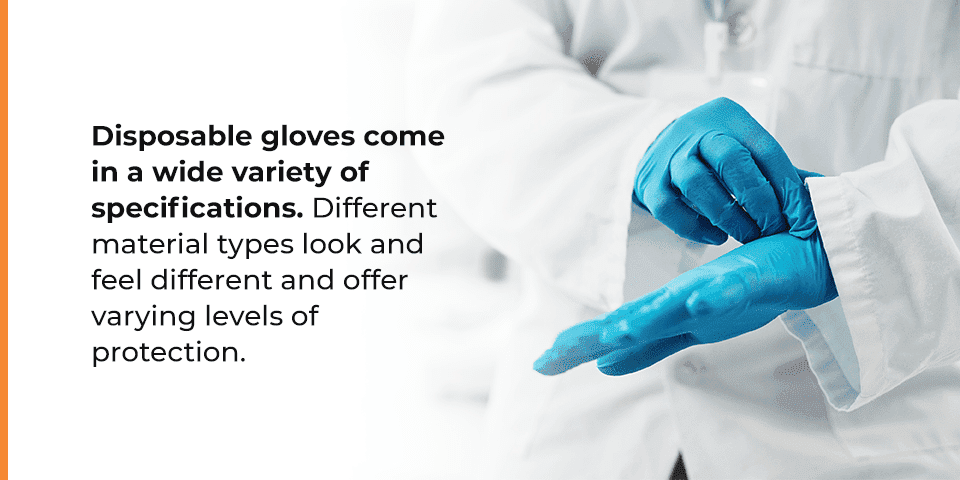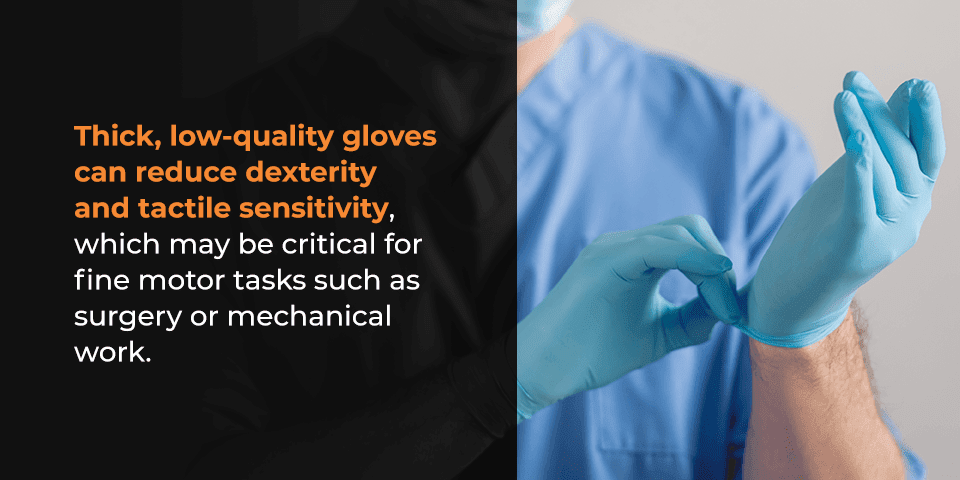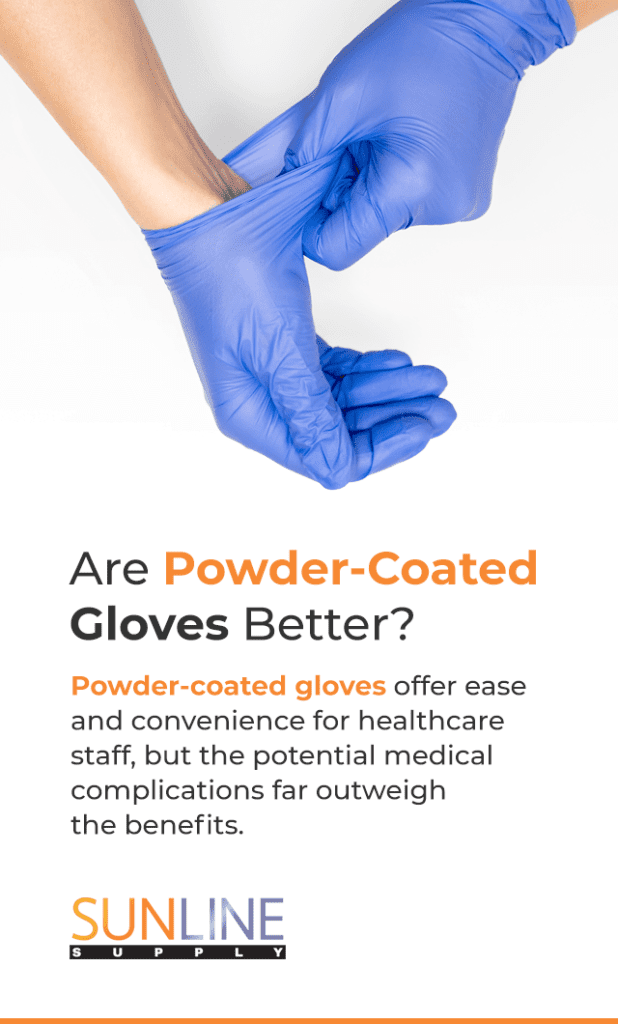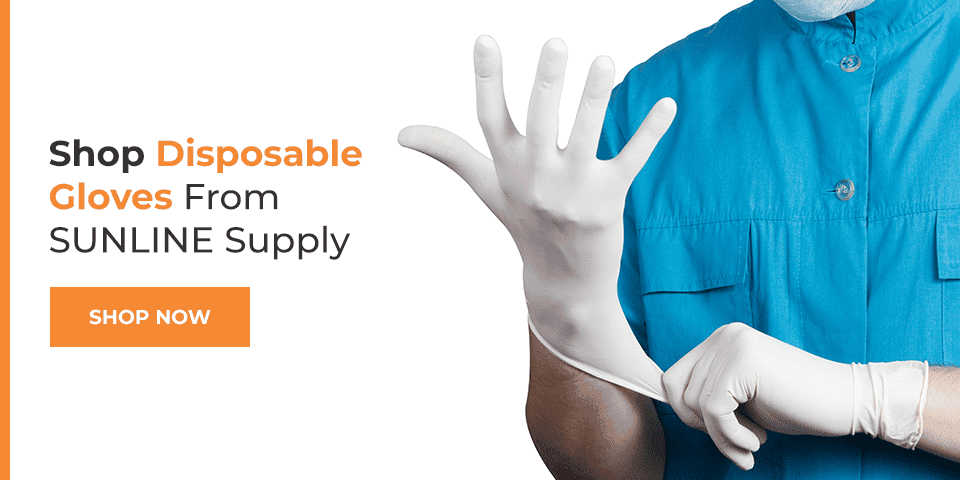
Debunking Common Myths About Disposable Gloves
Whether we see disposable gloves on cafeteria workers, janitors or dentists, we recognize the use of personal protective equipment (PPE) that helps protect both the wearers and us from germs, chemicals and other harmful substances. Although countless occupations and industries require disposable gloves, many people still have questions and misconceptions about them. Can disposable gloves give you allergies? Are all disposable gloves made of the same material? Which types of gloves are best suited for which types of tasks?
At SUNLINE Supply, we want to debunk common myths about disposable gloves to help your company purchase and use them more effectively.

Can Any Disposable Glove Be Used for Any Job?
Disposable gloves come in a wide variety of specifications. Different material types look and feel different and offer varying levels of protection. Choosing a suitable material based on your industry is an important consideration when purchasing disposable gloves for your staff. Durability, resistance to chemicals, grip, fit and affordability are the main factors to think about here.
- Latex: Latex comes from natural rubber and offers excellent flexibility and tactile sensitivity. Cheap, convenient and easy to put on, latex gloves are standard in the medical, automotive, janitorial and beauty industries. However, latex gloves can cause allergic reactions, and in 2017 the Food and Drug Administration (FDA) banned powdered latex gloves for medical use in the United States.
- Nitrile: Nitrile gloves are a mainstay of the janitorial and automotive industries due to their resistance to chemicals, abrasion and puncturing. They are also gaining popularity in medical fields due to the prevalence of latex allergies. Thanks to their greater durability, nitrile gloves offer great value for extended use. Medical and industrial-grade nitrile gloves come in a range of bright, eye-catching colors, which may provide better functionality in dark environments where workers need to see their hands.
- Vinyl: With their looser fit, vinyl gloves are ideal for industries such as food preparation and child care, which require frequent gloves changes. Vinyl is allergy-friendly and offers protection from germs and temperatures but isn’t suitable for handling hazardous materials.
- Poly: Like vinyl, polyethylene gloves are excellent for the food industry due to their affordability and ease of use. Poly gloves provide mid-range comfort and sensitivity but are not impervious to liquids or dangerous chemicals.
- Powder vs. powder-free: Most gloves — particularly latex and vinyl — come in powder and powder-free options. The purpose of the cornstarch or talcum powder coating on gloves is to make the gloves easier to put on and less prone to becoming slippery from perspiration. However, for medical occupations, the risks of infection, irritation and allergic reaction to the patient outweigh the wearer’s improved comfort.
Are Gloves Always 100% Latex, Vinyl or Nitrile?
Though some glove manufacturers and suppliers may claim that their gloves are 100% latex, vinyl or nitrile, a glove made entirely from its respective material would not be usable. In reality, glove manufacturing requires the use of various fillers to create a functional product. Natural latex and nitrile require curing agents, cross-link agents and accelerators for a durable glove, while vinyl needs plasticizers and activation agents. Most glove formulations require a small percentage of fillers for the best performance.
The use of fillers isn’t necessarily a red flag when choosing what gloves to purchase and use. Fillers make glove production more economical and can improve the quality of the glove itself. For example, the addition of calcium carbonate to latex gloves can improve tear strength.
However, formulations that incorporate a significant amount of filler offer diminishing returns. As the gloves lose durability, workers will need to use more of them, resulting in a higher cost for the company. For this reason, you should check the formulations of different glove options to ensure you’re not purchasing an overly blended glove. Fillers are a necessary component of disposable gloves, but too much indicates an inferior quality product.
Can Disposable Gloves Give You Allergic Reactions?
Glove manufacturers have improved their ability to produce non-allergenic gloves, but even newer formulations cannot completely eliminate the possibility of allergic reactions. Many workers who experience an allergic reaction to latex gloves have a Type I latex allergy, which is caused by allergenic proteins from the rubber trees that produce natural latex. Type I allergies can cause reactions like coughing, sneezing and rashes, as well as irritation of the skin under the gloves. Though manufacturers can leach much of the problematic allergenic proteins, some of the proteins are still left over.
A common myth about nitrile gloves is that they are 100% allergy-friendly. Though often used as an alternative to latex, nitrile gloves can also cause allergic reactions. As with latex gloves, the rubber itself does not usually cause the reaction. These instances are typically Type IV reactions to additive chemicals in the gloves and limited to the skin in contact with the glove material. For those highly sensitive to nitrile gloves, additive-free options may be available.
If you’re particularly concerned about the risk of allergic reactions, you might consider purchasing vinyl gloves for your company. Allergic reactions to vinyl gloves are practically unheard of. Any vinyl-related allergic reaction is usually a condition known as contact urticaria — skin irritation caused by sweating and lack of ventilation inside the glove.
In general, disposable gloves do carry a risk of causing allergic reactions, but making the right choice about glove material will help you avoid this risk to your staff.
Do You Need to Wash Your Hands If You Use Disposable Gloves?
Though it may seem like the use of disposable gloves eliminates the risk of contact with hazardous substances, disposable gloves do not provide complete protection. PPE reduces but does not eliminate the possibility of contamination of workers’ skin and clothing. Contamination frequently occurs when healthcare personnel remove their gloves and gowns. Hand hygiene by rubbing or washing is the standard protection against contamination after glove removal.
Apart from choosing the correct material and size of disposable gloves, the World Health Organization (WHO) makes several recommendations on proper glove use in healthcare settings:
- Do not change or replace hand hygiene procedures such as rubbing alcohol-based products or washing with soap and water.
- Wear gloves whenever contact with mucous membranes, bodily fluids, blood, non-intact skin or infectious material is possible.
- Change or remove gloves before caring for a different patient.
- Change or remove gloves when patient care moves from a potentially contaminated body site to another body site.
- Do not reuse gloves.
Disposable gloves effectively protect against contamination when healthcare staff use them appropriately and hand hygiene remains standard procedure. Be sure to know when and how to put on and remove gloves so no resources go to waste, and keep routine hand hygiene — washing with soap and water or rubbing with an alcohol-based product — a top priority.
Can I Wear the Same Pair of Disposable Gloves All Day?
Periodically changing your pair of disposable gloves is an integral part of avoiding contamination, especially in the medical and food service industries. Workers should always put on a new pair of gloves when moving from one patient to another or from one task to another, such as handling uncooked ingredients to handling cooked ingredients or using disinfecting products to holding a customer’s plate. Severe food allergies are another critical concern for food service workers, who should always change gloves after handling potential food allergens.
Disposable gloves lose their effectiveness as PPE when they are ripped, torn or otherwise damaged — but even if they aren’t visibly damaged, gloves lose their protective barrier over time. You should never wear the same pair of disposable gloves all day. In general, you should change your gloves every couple of hours and wash your hands between each pair.
Food service workers do not need to change gloves after handling money, as food outbreak investigations have not identified handling money as a cause of illness. This consideration can save resources for your company, though customers may complain if they see workers handling food and money with the same pair of gloves.
In a healthcare setting, staff should remove and replace gloves every couple of hours and between caring for different patients. Along with hand hygiene, frequent glove changing helps prevent contamination and the spread of germs and hazardous chemicals between workers, patients and environments.

Are Thicker Gloves Stronger?
Glove thickness is usually given in mils, a unit equal to 1 one-thousandth of an inch. Most disposable nitrile gloves are 4 mils thick, but they may be as thick as 8 to 15 mils. As you consider different disposable glove options, keep in mind that thicker does not necessarily mean stronger or safer. Though a physically thicker barrier might seem like a guarantee of better protection, the glove manufacturer may have added cheap fillers to the formulation at the expense of glove strength and flexibility, necessitating a thicker glove to compensate. As a result, the product may be more susceptible to abrasions, punctures and tears.
Wearing thicker gloves or wearing an additional pair of gloves can do more harm than good. Thicker gloves may be of lower quality, and double gloving can reduce hand mobility, increase hand fatigue and cause overheating. Thicker gloves are less safe due to their potentially compromised strength, and they may also interfere with the work at hand. Thick, low-quality gloves can reduce dexterity and tactile sensitivity, which may be critical for fine motor tasks such as surgery or mechanical work.
Do Disposable Gloves Expire?
Glove material may degrade over time, but in general, disposable gloves may be stored for up to 10 years without losing their effectiveness as PPE. Exposure to moisture or heat will accelerate the degradation of the glove material. Additionally, ultraviolet light and ozone will quickly degrade the polymer composition of the glove material. Natural rubber gloves are particularly susceptible to damage from ultraviolet light, even from weak sources like fluorescent bulbs and lamps.
Latex gloves have a stated shelf life of three years, while nitrile gloves have a stated shelf life of five years. If you are uncertain about the safety of older gloves, only use them for training, gardening, cleaning or another low-risk activity.
The appearance of unsafe gloves is unmistakable, including factors like:
- Surface cracks appearing when you stretch the glove during use.
- A brittle, hardened appearance that easily breaks apart.
- Loss of elasticity, making properly donning and removing the gloves more difficult, increasing the risk of contamination.
To maximize the shelf life of your disposable gloves, be sure to:
- Never break the seal on the original packaging until workers need to use them.
- Store them in a cool, dry place with a temperature below 90 degrees Fahrenheit.
- Keep them away from UV light for extended periods.
- Keep them away from ozone, which is produced by some electrical equipment and motors.
- Watch out for unexpected sources of heat like nearby radiators and steam pipes.

Are Powder-Coated Gloves Better?
In the past, glove manufacturers sold gloves coated in powder such as cornstarch or talcum to make them easier to put on and take off. However, as mentioned above, the FDA passed a medical device ban on powdered gloves in early 2017. Medical device bans are rare — the only other medical ban is on prosthetic hair fibers. However, the FDA has the authority to ban any medical device that it deems, based on all available information and data, to be deceptive towards patients or users or substantially dangerous to use in a way that updated labeling or directions cannot correct.
The FDA determined that powder-coated gloves present an unreasonable risk of injury to both patients and healthcare staff. When internal body tissues become exposed to airborne powder particles from gloves, allergic reactions and airway inflammation may follow. Additionally, the airborne powder particles may trigger an immune response, causing granulomas — tissue forming around the particles — or scar tissue formation that can lead to surgical complications. The FDA also based the ban on the possibility of post-operative wound infections resulting from surgeries involving powder-coated gloves. Though these considerations address the healthcare industry, they also apply to any workers who frequently use disposable gloves during their day-to-day work.
Powder-coated gloves offer ease and convenience for healthcare staff, but the potential medical complications far outweigh the benefits. The FDA’s final ruling on powder-coated gloves outlines these downsides, which are well worth noting before choosing what disposable gloves to purchase for your company.

Shop Disposable Gloves From SUNLINE Supply
Disposable gloves are essential for personal protection in many industries, including healthcare, food service, beauty and automotive repair. After debunking some common myths about disposable gloves, we hope to help you make the best choice of disposable gloves to optimize the safety and productivity of your company. Browse our wide selection of quality disposable gloves and PPE at low prices and with bulk availability. Contact us at SUNLINE Supply today!

